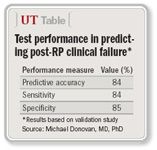Article
Test shows 84% accuracy in predicting post-radical prostatectomy failure
A predictive model that incorporates the androgen receptor concentration of prostate cancer cells can identify patients who have an increased risk of clinical failure 5 years after radical prostatectomy.

Key Points


"High levels of androgen receptors correlated with a shorter time to clinical failure," explained study co-author Michael Donovan, MD, PhD, senior vice president of research collaborations for Aureon Laboratories (Yonkers, NY), the company that developed the test. "There is a suggestion in the initial analysis that there is a role for the androgen receptor in terms of predicting therapeutic response with respect to time to clinical failure."
An initial set of 33 variables was pared to six, forming the basis for the predictive model. Test results are reported as a single number ranging from 0 to 100.
The test was used to evaluate prostatectomy specimens from 758 patients treated at Sloan-Kettering between 1985 and 2003. The primary outcome was clinical failure at 5 years, defined as a rise in PSA values from castrate levels, development of bone or soft-tissue metastases, or prostate cancer death.
In a training cohort of 373 patients, the test achieved overall 92% predictive accuracy, including 90% sensitivity and 91% specificity. Sloan-Kettering collaborators then evaluated the test in a validation cohort of 385 patients. The validation study had an 84% predictive accuracy, 84% sensitivity, and 85% specificity. Test results correlated significantly (p<.001) with the risk of clinical failure at 5 years.
Outcome data were available for 63 patients who received androgen deprivation therapy. Clinical failure had occurred in 32 men. The androgen receptor concentration of racemase-negative epithelial cells correlated significantly with a shortened time to clinical failure in patients who experienced clinical failure (p=.002).
Dr. Donovan said a predictive model for evaluating needle biopsy cores has reached the final stages of development. "The ability to use needle biopsy tissue is totally within the confines of the analysis system we have developed," he added.





